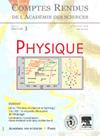纳米力学服务于聚合物基复合材料的研究
IF 1.2
4区 物理与天体物理
Q3 ASTRONOMY & ASTROPHYSICS
引用次数: 7
摘要
在过去的二十年里,纳米力学测试和建模取得了巨大的进步。这一进展来自材料科学的不同领域,涉及薄膜和涂层、聚合物混合物、纳米材料或微结构成分的机械行为,以及快速发展的MEMS领域。纳米力学测试方法包括纳米压痕,在扫描或透射电子显微镜下进行原位测试,结合数字图像相关,原子力显微镜与新的先进动态模式,微柱压缩或分裂,芯片上测试,或缺口微束弯曲。当这些方法结合在一起时,可以揭示微观甚至纳米尺度上的弹性、塑性、蠕变和断裂性能。包括原子模拟和几种粗粒度方法在内的建模技术已经丰富到可以以现实的方式处理复杂尺寸,界面或表面效果的水平。有趣的是,与其他领域相比,将这种模式转移到先进的长纤维增强聚合物复合材料并没有那么激烈。在这里,我们表明,这些方法放在一起可以为在基本纤维基质水平(包括界面和界面相)改进响应特征提供新的视角。然而,仍有许多悬而未决的问题有待解决。此外,这是长度尺度,通常低于10微米,*通讯作者。ISSN(电子):1878-1535 https://comptes-rendus.academie-sciences.fr/physique/本文章由计算机程序翻译,如有差异,请以英文原文为准。
Nanomechanics serving polymer-based composite research
Tremendous progress in nanomechanical testing and modelling has been made during the last two decades. This progress emerged from different areas of materials science dealing with the mechanical behaviour of thin films and coatings, polymer blends, nanomaterials or microstructure constituents as well as from the rapidly growing field of MEMS. Nanomechanical test methods include, among others, nanoindentation, in-situ testing in a scanning or transmission electron microscope coupled with digital image correlation, atomic force microscopy with new advanced dynamic modes, micropillar compression or splitting, on-chip testing, or notched microbeam bending. These methods, when combined, reveal the elastic, plastic, creep, and fracture properties at the microand even the nanoscale. Modelling techniques including atomistic simulations and several coarse graining methods have been enriched to a level that allows treating complex size, interface or surface effects in a realistic way. Interestingly, the transfer of this paradigm to advanced long fibre-reinforced polymer composites has not been as intense compared to other fields. Here, we show that these methods put together can offer new perspectives for an improved characterisation of the response at the elementary fibre-matrix level, involving the interfaces and interphases. Yet, there are still many open issues left to resolve. In addition, this is the length scale, typically below 10 micrometres, ∗Corresponding author. ISSN (electronic) : 1878-1535 https://comptes-rendus.academie-sciences.fr/physique/
求助全文
通过发布文献求助,成功后即可免费获取论文全文。
去求助
来源期刊

Comptes Rendus Physique
物理-天文与天体物理
CiteScore
2.80
自引率
0.00%
发文量
13
审稿时长
17.2 weeks
期刊介绍:
The Comptes Rendus - Physique are an open acess and peer-reviewed electronic scientific journal publishing original research article. It is one of seven journals published by the Académie des sciences.
Its objective is to enable researchers to quickly share their work with the international scientific community.
The Comptes Rendus - Physique also publish journal articles, thematic issues and articles on the history of the Académie des sciences and its current scientific activity.
From 2020 onwards, the journal''s policy is based on a diamond open access model: no fees are charged to authors to publish or to readers to access articles. Thus, articles are accessible immediately, free of charge and permanently after publication.
The Comptes Rendus - Physique (8 issues per year) cover all fields of physics and astrophysics and propose dossiers. Thanks to this formula, readers of physics and astrophysics will find, in each issue, the presentation of a subject in particularly rapid development. The authors are chosen from among the most active researchers in the field and each file is coordinated by a guest editor, ensuring that the most recent and significant results are taken into account. In order to preserve the historical purpose of the Comptes Rendus, these issues also leave room for the usual notes and clarifications. The articles are written mainly in English.
 求助内容:
求助内容: 应助结果提醒方式:
应助结果提醒方式:


